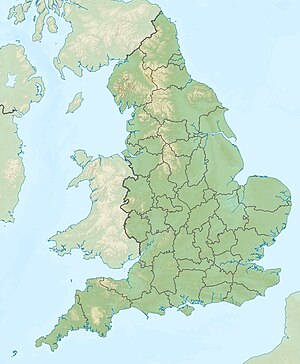Tarn Hows
| Tarn Hows | ||
|---|---|---|

|
||
| View over Tarn Hows | ||
| Geographical location | England , Cumbria | |
| Tributaries | unnamed | |
| Drain | Tom Gill | |
| Islands | 4th | |
| Data | ||
| Coordinates | 54 ° 23 '27.8 " N , 3 ° 2' 2.8" W | |
|
|
||
| Altitude above sea level | 498 m ASL | |
| length | 122 m | |
| width | 75 m | |
| Maximum depth | 5 m | |
|
particularities |
Site of Special Scientific Interest |
|
Tarn Hows (sometimes also The Tarns ) is a lake in the Lake District , Cumbria , England . Tarn Hows actually refers to an area between the towns of Hawkshead and Coniston , but it is now also used for the lake. Today's lake goes back to the connection of the original three lakes High Tarn, Middle Tarn and Low Tarn. The lake has only small unnamed tributaries. The Tom Gill forms its outlet in the southwest of the lake.
The name is derived from the Old Norse word "tjorn", which means "tear" and the also Old Norse "how" which means hill.
The land and the three lakes belonged to the industrialist James Garth Marshall. He also owned the Monk Coniston Hall country estate and, in order to impress his visitors there, he gave the three lakes and their surrounding land their present-day appearance in the 19th century, so that the site can be reached on a simple walk since then, and only there is another lake.
In 1929 Beatrix Potter bought the Tarn Hows area for £ 15,000 . She immediately sold the lake and land around it to the National Trust , to which she bequeathed the rest of the land in her will upon her death in 1943.
The National Trust erected a memorial stone for Sir James Scot of Yews and Anne Lady Scot in the southeast of the area in 1930. The view from the memorial stone over Tarn Hows is one of the most photographed views in the Lake District, just as the lake is one of the most visited places in the national park.
The lake has been a Site of Special Scientific Interest since 1965 . The area is home to the European (red) squirrels, which are critically endangered in England .
See also
Web links
- Tarn Hows on Lakes, Meres, Tarns and Waters
- Tarn How Site of Special Scientific Interest at English Nature
- Tarn Hows at National Trust
- Tarn Hows at English Lakes
- Tarn Hows at Visit Cumbria
- Tarn Hows Walk at Lake District Walks
